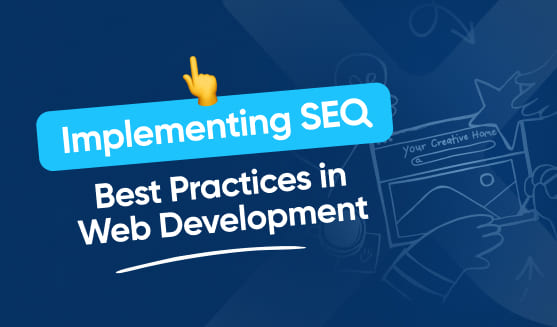
In today’s digital landscape, implementing SEO best practices is crucial to the success of any website. As a web developer, understanding the basics of SEO is essential to ensure that your site is visible to search engines and attracts organic traffic. This article will delve into the core elements of SEO, the intersection of SEO and web development, keyword research and implementation, optimizing on-page SEO elements, and enhancing site performance for better SEO.
Understanding the Basics of SEO
Search Engine Optimization (SEO) is the practice of optimizing a website to improve its visibility and ranking on search engine results pages (SERPs). It involves various strategies and techniques that help search engines understand and interpret the content on your site, allowing them to match relevant queries with your web pages.
SEO is crucial because the majority of online experiences start with a search engine. When users search for information, products, or services, they rely on search engines to provide them with the most relevant and trustworthy results.
Defining SEO and Its Importance
SEO encompasses both on-page and off-page optimization techniques. On-page SEO focuses on optimizing elements within your website, such as meta tags, headings, and content, to make it more search engine-friendly. Off-page SEO, on the other hand, involves activities outside your website, such as link building and social media engagement, to improve your site’s visibility and credibility.
The importance of SEO in web development cannot be overstated. By implementing SEO best practices, you increase the chances of your website ranking higher on search engine results, leading to increased organic traffic, brand exposure, and potential conversions.
Core Elements of SEO
Several core elements contribute to successful SEO. These include relevant keywords, high-quality content, user experience, website architecture, and technical optimization.
Keywords are the foundation of SEO. By conducting comprehensive keyword research, you can identify the words and phrases that your target audience uses when searching for information related to your website’s offerings. By strategically incorporating these keywords into your content, headers, and metadata, you can increase the relevance of your website to specific search queries.
High-quality content that meets the needs of users is essential for effective SEO. Search engines prioritize websites that provide valuable and relevant information. Creating authoritative and engaging content helps establish your website as a reliable source of information, leading to higher rankings and increased traffic.
User experience plays a significant role in SEO. Search engines consider metrics like bounce rate, time on site, and pages per session to determine how satisfied users are with your website. By ensuring your site is user-friendly, loads quickly, and provides an intuitive navigation structure, you improve user experience and increase the likelihood of higher rankings.
Website architecture and technical optimization are crucial elements of SEO. Search engines prefer websites that are well-structured, have organized URLs, and are easily crawlable. By optimizing your website’s technical aspects, such as XML sitemaps, robots.txt files, and canonical tags, you enhance your site’s visibility and accessibility to search engines.
Another important aspect of SEO is the concept of backlinks. Backlinks are links from other websites that point to your site. They are like votes of confidence from other sites, indicating to search engines that your website is trustworthy and authoritative. The quality and quantity of backlinks can significantly impact your site’s ranking in search results.
Furthermore, local SEO is becoming increasingly important for businesses with physical locations. Local SEO focuses on optimizing your website to appear in local search results, especially when users search for products or services in a specific geographic area. This can be achieved through strategies such as creating location-specific landing pages, optimizing Google My Business profiles, and obtaining positive reviews from local customers.
Lastly, it’s worth mentioning that SEO is an ongoing process. Search engines constantly update their algorithms to provide users with the best possible results. Therefore, it’s essential to stay up to date with the latest SEO trends and adapt your strategies accordingly to maintain and improve your website’s visibility and ranking.
SEO in the Context of Web Development
Web development and SEO go hand in hand. A well-optimized website requires a solid foundation in web development principles. Understanding the intersection of SEO and web development is crucial for creating websites that are not only visually appealing but also search engine-friendly.
The Intersection of SEO and Web Development
Web developers need to consider SEO principles during the various stages of website creation. From the planning and design phase to the development and launch, integrating SEO into the web development process ensures that your website is optimized from the ground up.
During the planning and design phase, you need to conduct thorough keyword research to identify the key terms associated with your website’s offerings. This research helps inform decisions related to domain names, site structure, and content hierarchy.
When it comes to web development and SEO, website design and architecture play a crucial role. The layout, navigation, and overall structure of your website should be intuitive and user-friendly. Additionally, creating a responsive design that caters to mobile users is vital, as search engines prioritize mobile-friendly websites.
SEO-Friendly Web Design and Architecture
Web developers can implement various techniques to create SEO-friendly websites. One essential aspect is creating clean, crawlable code that search engines can easily understand. This includes using semantic HTML tags, avoiding excessive use of JavaScript, and optimizing code for faster page loading.
Another crucial aspect of SEO-friendly web design is implementing proper URL structure. URLs should be descriptive, keyword-rich, and easy for both users and search engines to comprehend. Additionally, utilizing metadata elements such as title tags and meta descriptions help improve click-through rates and keyword optimization.
Web developers should also prioritize creating a clear and logical site hierarchy. By organizing your content into logical categories and using HTML heading tags appropriately, you help search engines understand the structure and context of your website and its pages.
Keyword Research and Implementation
Keyword research is the foundation of successful SEO. Understanding the role of keywords and employing effective strategies for keyword implementation is essential for optimizing your website for search engines.
The Role of Keywords in SEO
Keywords serve as the bridge between what users search for and the content on your website. By identifying and targeting the right keywords, you increase the visibility and relevancy of your site in search engine results.
Keyword research involves analyzing search volumes, competitiveness, and relevancy to your website. By using keyword research tools, you can discover the phrases and terms your target audience uses, giving you insight into their search intent.
Strategies for Effective Keyword Implementation
Once you have determined the keywords relevant to your website, it is crucial to implement them strategically throughout your content. Incorporate keywords naturally in page titles, headings, URL structures, meta descriptions, and body content.
However, it is essential to avoid keyword stuffing, which can negatively impact your website’s visibility and rankings. Focus on producing high-quality, relevant content that incorporates keywords naturally and offers value to users.
Aside from on-page keyword implementation, consider using keywords in your website’s navigation labels, internal and external links, and image alt tags. These elements further enhance the relevance of your website and its pages.
Optimizing On-Page SEO Elements
On-page SEO elements are crucial components to consider when aiming to improve your website’s visibility in search engine results. Optimizing meta tags, images, and multimedia elements plays a significant role in attracting organic traffic.
Importance of Meta Tags
Meta tags provide concise information about a webpage’s content. The meta title, meta description, and meta keywords tags are essential components that influence how search engines display and rank your web pages.
When optimizing meta tags, make sure to include relevant keywords, create unique tags for each page, and write compelling descriptions that entice users to click through to your site.
Optimizing Images and Multimedia Elements
Images and multimedia elements add visual appeal and engagement to your website. However, search engines cannot interpret images and multimedia directly, so optimizing them is crucial for SEO.
When adding images, use descriptive file names and include relevant keywords. Additionally, optimize the alt text attribute by providing alternative text that accurately describes the image’s content. This not only improves accessibility but also allows search engines to understand and index your images.
Compressing images and multimedia files helps improve website loading speed, a vital factor in SEO. Large file sizes can slow down your website, negatively affecting user experience and search engine rankings. Therefore, optimizing these files for web usage is essential.
Enhancing Site Performance for Better SEO
Site performance is a critical factor in SEO success. Creating a fast, responsive website that caters to both desktop and mobile users is essential for achieving higher rankings in search engine results.
Importance of Site Speed
Site speed directly impacts user experience and search engine rankings. Websites that load quickly offer a better user experience, leading to increased engagement, lower bounce rates, and higher conversion rates.
To enhance site speed, utilize techniques such as image optimization, minifying JavaScript and CSS files, leveraging browser caching, and optimizing server response times. Regularly monitoring and analyzing your website’s loading speed is essential to identify and address performance bottlenecks.
Mobile Optimization and SEO
In today’s mobile-centric world, mobile optimization is crucial for SEO. With the majority of searches performed on mobile devices, search engines prioritize mobile-friendly websites in their rankings.
Creating a responsive website design that adapts to different screen sizes and resolutions ensures optimal user experience across devices. Implementing mobile-specific features, such as touch-friendly buttons and menus, further enhances mobile optimization.
It is also important to optimize your website’s mobile loading speed. This involves minimizing the use of large files and excessive scripts, prioritizing content, and utilizing browser caching to reduce load times.
Implementing SEO best practices in web development is a continuous process. By understanding the basics of SEO, conducting comprehensive keyword research, optimizing on-page elements, and enhancing site performance, you can create websites that are not only visually appealing but also search engine-friendly. By incorporating these strategies into your web development workflow, you can improve your website’s visibility, attract organic traffic, and achieve long-term SEO success.


